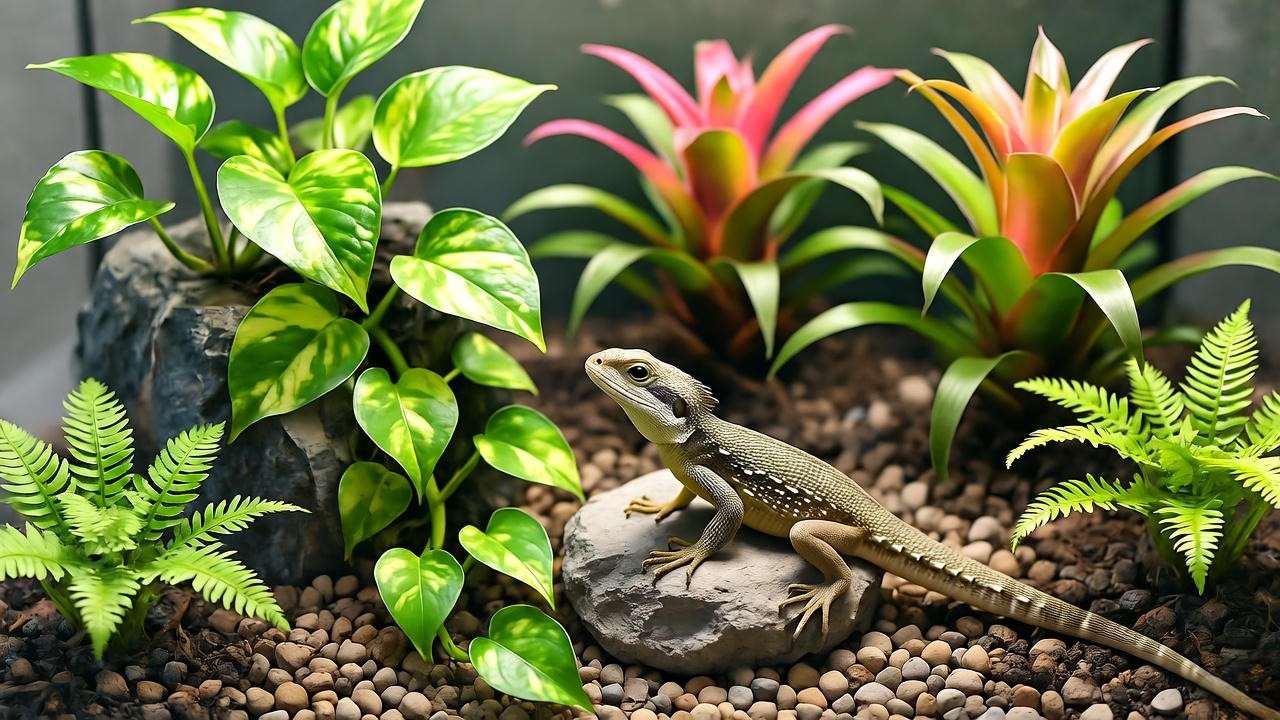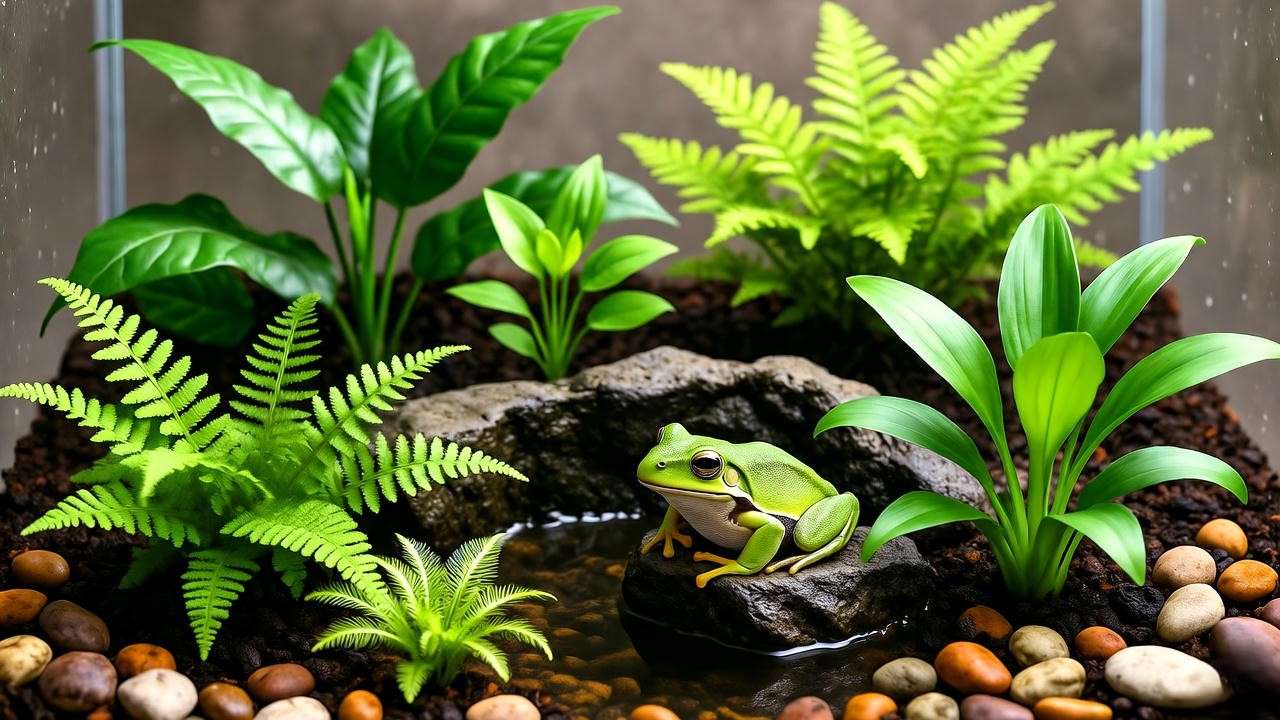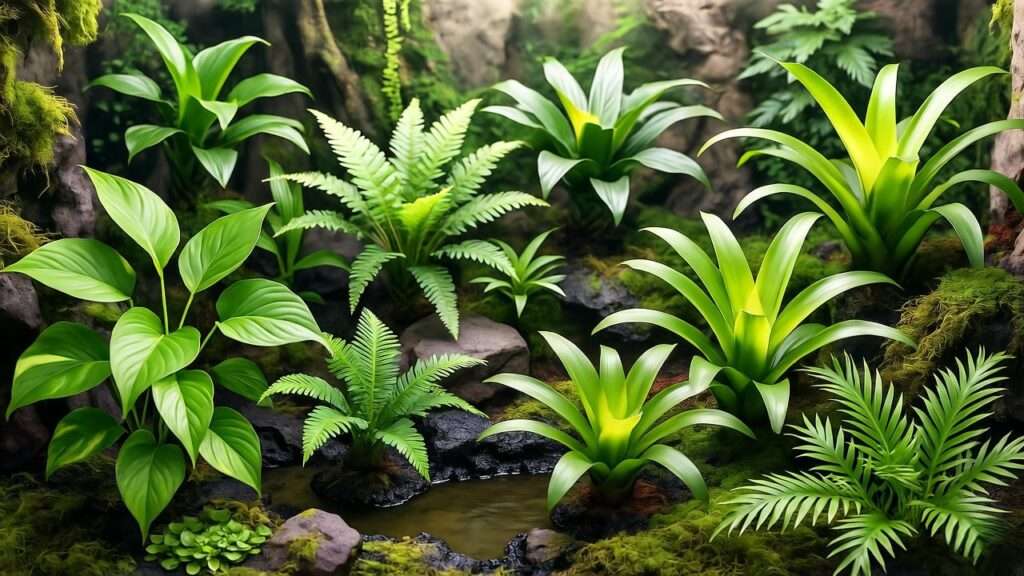Picture this: a vibrant, miniature jungle thriving in your living room, where lush vivarium plants weave a tapestry of green, providing a perfect habitat for your reptiles, amphibians, or invertebrates. 🌴 A well-designed vivarium is more than just a pet enclosure—it’s a living ecosystem that captivates the eye and nurtures its inhabitants. But choosing the wrong plants can lead to wilting foliage, unhappy pets, or a maintenance nightmare. 😓 In this guide, we’ll explore the top 10 vivarium plants that are beautiful, pet-safe, and easy to care for, along with expert tips to ensure your terrarium flourishes. Whether you’re a beginner or a seasoned enthusiast, you’ll discover how to create a stunning, low-maintenance vivarium that thrives for years. 🌸
Why It Matters: Vivarium plants do more than enhance aesthetics—they regulate humidity, provide oxygen, and create natural hiding spots for animals. Picking the right ones ensures a balanced ecosystem and a happy home for your pets. 🦎 What You’ll Learn: From plant selection to care techniques, this article offers a comprehensive roadmap to building a thriving terrarium, backed by botanical and herpetological expertise. Let’s dive in! 🌍
Section 1: What Are Vivarium Plants, and Why Are They Important? 🐢
Understanding Vivariums and Their Unique Needs
A vivarium is a controlled environment designed to house both plants and animals, such as reptiles, amphibians, or invertebrates. Think terrariums for lizards, paludariums with water features for frogs, or arid setups for desert-dwelling creatures. Each type—tropical, desert, or temperate—has specific environmental needs, and vivarium plants play a critical role in meeting them. 🌬️
Plants in a vivarium aren’t just decorative. They regulate humidity, provide shade, and produce oxygen, creating a natural habitat that reduces stress for animals. For example, a tropical vivarium for dart frogs needs moisture-loving plants like ferns, while a desert setup for a bearded dragon calls for drought-tolerant species like snake plants. Choosing plants that align with your vivarium’s conditions ensures a thriving ecosystem. 🌿
Expert Insight: Dr. Emily Carter, a herpetologist with 15 years of experience, explains, “Plants are the backbone of a vivarium’s ecosystem. They mimic the natural habitats of reptiles and amphibians, providing both functional and psychological benefits.” 🧑🔬

Why Choose the Right Plants?
The wrong plants can disrupt your vivarium’s balance. High-maintenance species may wilt in humid conditions, while toxic plants can harm pets. For instance, philodendrons, while beautiful, can be toxic to some reptiles. 🚫 Conversely, the right vivarium plants enhance aesthetics, support animal health, and require minimal upkeep. Benefits include:
- Aesthetic Appeal: Lush greenery transforms a glass box into a living masterpiece.
- Humidity Control: Plants like mosses retain moisture, ideal for tropical setups.
- Pet Comfort: Plants provide hiding spots and climbing surfaces, reducing stress.
- Low Maintenance: Hardy plants like pothos thrive with basic care, perfect for beginners.
By understanding your vivarium’s needs and selecting appropriate plants, you set the stage for a thriving, low-effort ecosystem. 🌴
Section 2: Criteria for Choosing the Best Vivarium Plants 🌱
What Makes a Plant Perfect for a Vivarium?
Not all plants are suited for vivariums. The best vivarium plants meet specific criteria to ensure they thrive alongside your pets. Here’s what to consider:
- Size and Growth Habits: Compact plants like peperomia fit small enclosures, while climbers like pothos suit larger setups.
- Light, Humidity, and Temperature Tolerance: Tropical plants need high humidity, while desert plants thrive in dry, sunny conditions.
- Non-Toxicity: Always choose pet-safe plants, as some animals may nibble foliage.
- Ease of Maintenance: Low-care plants are ideal for beginners or busy hobbyists.
For example, a tropical vivarium with low light calls for shade-tolerant plants like ferns, while a desert vivarium needs sun-loving, drought-resistant species like air plants. 🌞
Matching Plants to Your Vivarium Type
Different vivariums require different plants:
- Tropical Vivariums: High humidity (70–90%), low to moderate light. Think bromeliads or mosses.
- Desert Vivariums: Low humidity, bright light. Snake plants or succulents excel here.
- Temperate Vivariums: Moderate conditions, versatile plants like spider plants work well.
Tip Box: 📝 Vivarium Plant Checklist
- Is the plant non-toxic to your pet?
- Does it match your vivarium’s light and humidity levels?
- Can it fit without overcrowding the enclosure?
- Is it low-maintenance enough for your skill level?
By aligning plants with your vivarium’s conditions, you ensure a harmonious and beautiful setup. 🌿
Section 3: The Top 10 Vivarium Plants for Stunning Terrariums 🌿
Our Expert Picks for Lush, Low-Maintenance Vivariums
After years of cultivating vivariums and consulting with botanists and herpetologists, we’ve curated the ultimate list of vivarium plants that combine beauty, functionality, and ease of care. Below are the top 10 plants, complete with care tips and ideal vivarium types.

1. Pothos (Epipremnum aureum)
Why It’s Great: Pothos, often called “devil’s ivy,” is a hardy, fast-growing plant with heart-shaped leaves. It’s non-toxic to most reptiles and amphibians, making it a go-to for vivariums. 🌱 Care Tips: Thrives in low to moderate light, needs occasional watering, and benefits from pruning to control growth. Vivarium Fit: Perfect for tropical or temperate setups; its trailing vines create natural climbing structures for arboreal pets like geckos.
2. Snake Plant (Sansevieria)
Why It’s Great: With its upright, sword-like leaves, the snake plant is striking and drought-tolerant, ideal for arid enclosures. 🌵 Care Tips: Requires minimal water and bright indirect light. Avoid overwatering to prevent root rot. Vivarium Fit: Best for desert or temperate vivariums housing bearded dragons or tortoises.
3. Bromeliads (Various species)
Why It’s Great: Bromeliads add vibrant colors and hold water in their central cups, boosting humidity for tropical setups. 🐸 Care Tips: Needs moderate light and occasional misting. Fill their cups with water for humidity. Vivarium Fit: Ideal for tropical vivariums, especially for dart frogs or small lizards.
4. Ferns (e.g., Boston Fern)
Why It’s Great: Ferns bring lush, feathery foliage that mimics rainforest floors, perfect for dense cover. 🌿 Care Tips: Loves high humidity, indirect light, and regular misting. Keep soil consistently moist. Vivarium Fit: Tropical or rainforest vivariums for frogs or chameleons.
5. Air Plants (Tillandsia)
Why It’s Great: These soil-free plants add unique textures and are easy to mount on branches or rocks. 🌬️ Care Tips: Soak weekly for 20–30 minutes, ensure good air circulation, and provide bright indirect light. Vivarium Fit: Desert or tropical vivariums with good ventilation, great for small enclosures.
6. Peperomia (Various species)
Why It’s Great: Compact and colorful, peperomia’s small size and low care needs make it a favorite. 🌸 Care Tips: Prefers moderate light and well-draining substrate. Water sparingly to avoid soggy soil. Vivarium Fit: Small tropical or temperate vivariums for geckos or small frogs.
7. Mosses (e.g., Sphagnum Moss)
Why It’s Great: Mosses create soft ground cover and retain moisture, ideal for humid environments. 🌧️ Care Tips: Requires high humidity, low light, and regular misting to stay lush. Vivarium Fit: Tropical or paludarium setups for amphibians or invertebrates.
8. Fittonia (Nerve Plant)
Why It’s Great: Known for its vibrant, veined leaves, fittonia thrives in humid conditions and adds a pop of color. 🌈 Care Tips: Needs indirect light and consistently moist soil. Mist regularly to maintain humidity. Vivarium Fit: Tropical vivariums for small reptiles or amphibians.
9. Spider Plant (Chlorophytum comosum)
Why It’s Great: Spider plants are air-purifying, pet-safe, and produce playful “pups” that add visual interest. 🌱 Care Tips: Thrives in moderate light with occasional watering. Tolerates a range of conditions. Vivarium Fit: Temperate or tropical setups for lizards or snakes.
10. Anubias (Anubias barteri)
Why It’s Great: This durable, aquatic or semi-aquatic plant is perfect for vivariums with water features. 💦 Care Tips: Grows in low light, can be submerged or emersed, and needs minimal care. Vivarium Fit: Paludariums or tropical setups with water elements for turtles or frogs.
| Plant | Vivarium Type | Light Needs | Care Level | Pet Safety |
|---|---|---|---|---|
| Pothos | Tropical/Temperate | Low-Moderate | Easy | Safe |
| Snake Plant | Desert/Temperate | Bright Indirect | Easy | Safe |
| Bromeliads | Tropical | Moderate | Moderate | Safe |
| Ferns | Tropical | Low-Moderate | Moderate | Safe |
| Air Plants | Desert/Tropical | Bright Indirect | Easy | Safe |
| Peperomia | Tropical/Temperate | Moderate | Easy | Safe |
| Mosses | Tropical/Paludarium | Low | Moderate | Safe |
| Fittonia | Tropical | Low-Moderate | Moderate | Safe |
| Spider Plant | Temperate/Tropical | Moderate | Easy | Safe |
| Anubias | Tropical/Paludarium | Low | Easy | Safe |
Section 4: How to Care for Vivarium Plants Like a Pro 🌟
Essential Care Tips for Thriving Vivarium Plants
Maintaining vivarium plants is straightforward with the right approach. Below, we break down the key care aspects to keep your plants lush and your ecosystem balanced.
Lighting Requirements
Lighting is critical for plant health. Most vivarium plants thrive in low to moderate light, but requirements vary:
- Tropical Plants (e.g., pothos, ferns): Prefer low to moderate light. Use LED grow lights with 6500K color temperature for 10–12 hours daily.
- Desert Plants (e.g., snake plants): Need bright indirect light or full-spectrum bulbs.
- Tools: Invest in a timer to automate light schedules, mimicking natural day-night cycles. 💡
Watering and Humidity
Vivarium plants often need higher humidity than houseplants, especially in tropical setups:
- Watering: Water sparingly for desert plants; keep soil moist (but not soggy) for tropical species.
- Misting: Use a handheld or automated mister to maintain 70–90% humidity for tropical plants.
- Tools: A hygrometer helps monitor humidity levels. Avoid overwatering to prevent mold. 🚿

Substrate and Planting
The right substrate anchors plants and supports their growth:
- Tropical Vivariums: Use coconut fiber or sphagnum moss for moisture retention.
- Desert Vivariums: Opt for sandy or rocky substrates.
- Planting Tips: Anchor climbing plants like pothos to branches or trellises; secure aquatic plants like anubias to rocks or driftwood.
Pruning and Maintenance
Regular maintenance keeps your vivarium tidy:
- Pruning: Trim pothos or ferns to control size and encourage bushy growth.
- Pest Prevention: Watch for fungus gnats in humid setups. Use neem oil or sticky traps for control. 🐞
- Cleaning: Remove dead leaves to prevent mold and maintain airflow.
Expert Tip: Create a self-sustaining vivarium by pairing plants with compatible growth rates and water needs. For example, combine mosses and bromeliads for a tropical setup with minimal upkeep. 🔄
Section 5: Common Mistakes to Avoid with Vivarium Plants 🚫
Pitfalls That Can Ruin Your Vivarium
Even with the best vivarium plants, mistakes can derail your terrarium’s success. Here are the most common pitfalls and how to avoid them, based on years of experience and insights from vivarium enthusiasts.
Choosing Toxic Plants
Some plants, while beautiful, are toxic to reptiles, amphibians, or invertebrates. For example, Dieffenbachia and philodendrons can cause irritation or worse if ingested by pets like geckos or frogs. 🚨
- Solution: Always research plant safety. Stick to pet-safe options like pothos, spider plants, or bromeliads. Check resources like the ASPCA’s list of non-toxic plants or consult a herpetologist.
- Pro Tip: If you’re unsure, contact a local exotic pet veterinarian to confirm a plant’s safety for your specific animal. 🩺

Overcrowding or Poor Placement
Cramming too many plants into a small vivarium can restrict animal movement, block light, and reduce airflow, leading to mold or stressed pets. 🌿
- Solution: Plan your layout with balance in mind. Use compact plants like peperomia for small enclosures and climbers like pothos for larger setups. Ensure plants don’t block basking spots or water features.
- Example: In a 20-gallon tropical vivarium, combine one bromeliad, a small fern, and a trailing pothos to avoid overcrowding while creating a lush look.
Neglecting Maintenance
Ignoring plant care can lead to yellowing leaves, wilting, or pest infestations, disrupting your vivarium’s ecosystem. 😓
- Solution: Monitor for signs of stress, such as yellowing leaves (overwatering or poor light) or drooping (underwatering or low humidity). Address issues promptly: adjust watering, increase misting, or improve lighting.
- Case Study: A vivarium enthusiast shared on a forum how their tropical setup failed due to overwatering mosses, causing mold. By switching to a well-draining substrate and reducing misting, they revived their terrarium within weeks. 📖
Expert Insight: “A vivarium is a living system—neglecting one element, like plant care, can throw everything off balance. Regular checks and small adjustments are key,” says terrarium designer Sarah Lin. 🌍
Section 6: Designing a Stunning Vivarium with Plants 🎨
Creating a Visually Appealing and Functional Vivarium
A well-designed vivarium is both a functional habitat and a work of art. By thoughtfully arranging vivarium plants, you can create a natural, immersive environment that delights both you and your pets. Here’s how to design a show-stopping terrarium.
Aesthetic Tips for Plant Arrangement
To mimic natural ecosystems, layer plants strategically:
- Ground Cover: Use mosses or fittonia for a lush base that retains moisture.
- Mid-Level Plants: Compact plants like peperomia or bromeliads add color and texture.
- Climbers or Trailers: Pothos or ferns create vertical interest, perfect for arboreal pets.
- Mix Textures and Colors: Pair the spiky leaves of snake plants with the soft fronds of ferns for contrast. Bright bromeliads or veined fittonia add pops of color. 🌈
Pro Tip: Place taller plants at the back or sides to create depth, ensuring animals have open space for movement.
Balancing Plants and Animals
Plants should enhance, not overwhelm, your vivarium.
- Space Considerations: Ensure plants don’t block basking areas or water features. For example, a bearded dragon needs open space for sunning, so avoid dense ferns in desert setups.
- Animal Needs: Provide hiding spots (e.g., ferns for shy frogs) or climbing surfaces (e.g., pothos for geckos). Ensure plants are sturdy enough to support active pets. 🦎
- Example: In a tropical vivarium for dart frogs, use bromeliads for humidity and hiding spots, paired with mosses for a soft, moist floor.
Inspiration from Nature
Replicate natural biomes for authenticity:
- Rainforest Vivarium: Combine ferns, mosses, and bromeliads to mimic a humid jungle. Add driftwood or vines for climbing. 🌴
- Desert Vivarium: Use snake plants and air plants with sandy substrate and rocks for an arid look. 🌵
- Paludarium: Blend anubias in water features with mosses and fittonia on land for a swampy aesthetic. 💦
DIY Tip: Step-by-Step Guide to Planting a Small Tropical Vivarium
- Choose a 20-gallon glass tank with a secure lid.
- Add a 2-inch layer of coconut fiber substrate for moisture retention.
- Plant one bromeliad in the center, a small fern on one side, and pothos trailing along the back.
- Mist daily and install a 6500K LED grow light for 10 hours daily.
- Add a small water dish for humidity and a hiding spot for your pet. 🛠️
Visual Inspiration: Search for “tropical vivarium designs” on platforms like Pinterest for stunning examples, or check out the bioactive vivarium community on forums for real-world setups. 📸
Section 7: FAQs About Vivarium Plants ❓
To address common reader questions and boost SEO, here are answers to frequently asked questions about vivarium plants:
Q: What are the easiest vivarium plants for beginners? A: Pothos, spider plants, and snake plants are ideal for beginners due to their hardiness, low light needs, and minimal watering requirements. They’re also pet-safe and adaptable to various vivarium types. 🌱
Q: Can I mix different plant types in one vivarium? A: Yes, as long as they share similar light and humidity needs. For example, pair pothos and ferns in a tropical setup, but avoid mixing desert snake plants with humidity-loving mosses.
Q: How do I prevent mold in a humid vivarium? A: Ensure good airflow with a small fan, use well-draining substrates, and avoid overwatering. Regular cleaning and monitoring humidity with a hygrometer help prevent mold growth. 🌬️
Q: Are there plants that are unsafe for reptiles or amphibians? A: Yes, plants like Dieffenbachia, philodendrons, and pothos relatives (if not true pothos) can be toxic. Always verify plant safety with a trusted source like a veterinarian or herpetology guide.
Q: How often should I mist vivarium plants? A: Tropical plants like ferns and fittonia need daily misting to maintain 70–90% humidity. Desert plants like snake plants require less frequent misting, about once a week. Use a hygrometer to monitor levels.
Q: Can vivarium plants survive without grow lights? A: Some low-light plants like pothos or anubias can survive with natural light, but grow lights ensure optimal growth, especially in enclosed setups with limited sunlight. 💡

Section 8: Conclusion: Build Your Dream Vivarium Today! 🌿
Creating a stunning vivarium is within your reach with the right vivarium plants and care techniques. From the hardy pothos to the vibrant bromeliads, these top 10 plants offer beauty, functionality, and ease for all skill levels. By selecting pet-safe, low-maintenance plants and following our expert care tips, you can craft a thriving ecosystem that delights both you and your pets. 🦋
Call to Action: Start your vivarium journey today! Pick one or two plants from this list, set up your terrarium, and share your creation with our plant care community on social media using #VivariumVibes. 🌐 Need a head start? Download our free vivarium plant care checklist at [insert website link] to keep your setup flourishing. 📥













